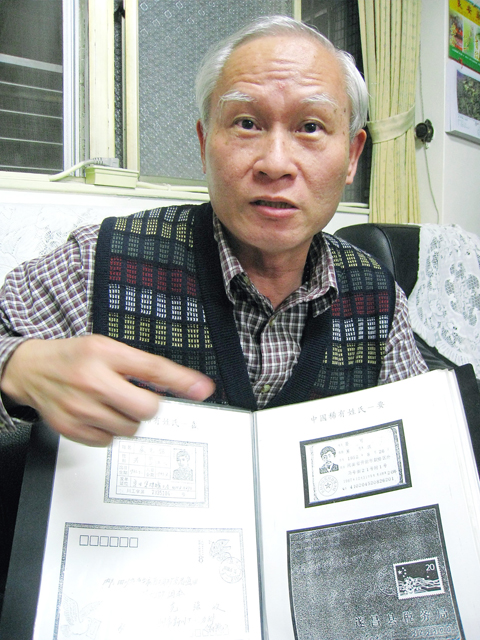A man who once was an avid stamp collector has turned his energies toward a different kind of collectible — surnames. Over the past decade, he has collected more than 200 rare Chinese surnames from friends, relatives, coworkers and even strangers he found in a telephone directory.
Kuo Chih-hsiang (郭智祥) collects surnames by sending an envelope to a person with an unusual surname and have him or her write back with a photocopy of any document that can prove that person’s identification.
Kuo said his surname collection began more than 10 years ago when he asked a Chinese man, Yao Ke (要可), with whom he intended to exchange stamps at the time, to prove his unusual family name. A month later, Kuo received a copy of Yao’s ID card via mail, which inspired him to start collecting rare Chinese surnames.

PHOTO: YANG JIOU-YIN, TAIPEI TIMES
At first, Kuo collected unusual surnames from friends who were also stamp collectors by exchanging postal products. Later, he started looking up strange surnames in a telephone directory. However, by doing so, he said he scared many people as he insisted on obtaining photocopies of their ID cards. At long last, he began accepting other types of identification, such as driver’s licenses, student IDs, diplomas, club membership cards, hospital receipts and even bank statements.
To complete the process, Kuo said he would first ask a person with a rare family name for his or her address and then send them a self-stamped envelope. After that, he would either visit in person to pick up the envelope or have the person mail it back.
Some of the rare surnames Kuo has collected include Hu (虎, tiger), Yi (蟻, ant), Shui (水, water), Yun (雲, cloud), Suo (鎖, lock), Dan (但, but) and Mai (買, buy).
Some of the surnames were so rare that the character could not be found on a computer, he said.
Pang Shou-neng (逄守能), a local postmaster in Taichung City, remembered that Kuo had to travel from Taipei to Taichung to meet him to pick up the necessary information for his collection.
“Seeing him so committed, I decided to make friends with him,” Pang said. “But since scams have become so prevalent, if he had asked me for a copy of my ID back then, I wouldn’t have given it to him.”
An elderly woman surnamed Tse (策) told Kuo that very few people had the surname Tse, adding that she was worried it would soon become extinct.
Kuo said this made him realize that his efforts were valuable.

US climber Alex Honnold is to attempt to scale Taipei 101 without a rope and harness in a live Netflix special on Jan. 24, the streaming platform announced on Wednesday. Accounting for the time difference, the two-hour broadcast of Honnold’s climb, called Skyscraper Live, is to air on Jan. 23 in the US, Netflix said in a statement. Honnold, 40, was the first person ever to free solo climb the 900m El Capitan rock formation in Yosemite National Park — a feat that was recorded and later made into the 2018 documentary film Free Solo. Netflix previewed Skyscraper Live in October, after videos

Starting on Jan. 1, YouBike riders must have insurance to use the service, and a six-month trial of NT$5 coupons under certain conditions would be implemented to balance bike shortages, a joint statement from transportation departments across Taipei, New Taipei City and Taoyuan announced yesterday. The rental bike system operator said that coupons would be offered to riders to rent bikes from full stations, for riders who take out an electric-assisted bike from a full station, and for riders who return a bike to an empty station. All riders with YouBike accounts are automatically eligible for the program, and each membership account

NUMBERS IMBALANCE: More than 4 million Taiwanese have visited China this year, while only about half a million Chinese have visited here Beijing has yet to respond to Taiwan’s requests for negotiation over matters related to the recovery of cross-strait tourism, the Tourism Administration said yesterday. Taiwan’s tourism authority issued the statement after Chinese-language daily the China Times reported yesterday that the government’s policy of banning group tours to China does not stop Taiwanese from visiting the country. As of October, more than 4.2 million had traveled to China this year, exceeding last year. Beijing estimated the number of Taiwanese tourists in China could reach 4.5 million this year. By contrast, only 500,000 Chinese tourists are expected in Taiwan, the report said. The report

Temperatures are forecast to drop steadily as a continental cold air mass moves across Taiwan, with some areas also likely to see heavy rainfall, the Central Weather Administration (CWA) said. From today through early tomorrow, a cold air mass would keep temperatures low across central and northern Taiwan, and the eastern half of Taiwan proper, with isolated brief showers forecast along Keelung’s north coast, Taipei and New Taipei City’s mountainous areas and eastern Taiwan, it said. Lows of 11°C to 15°C are forecast in central and northern Taiwan, Yilan County, and the outlying Kinmen and Lienchiang (Matsu) counties, and 14°C to 17°C